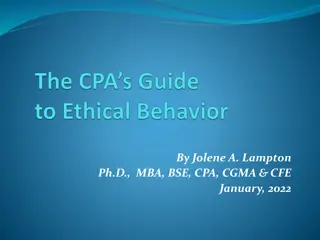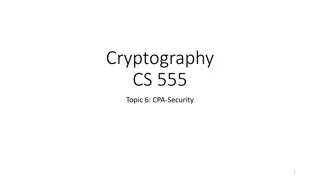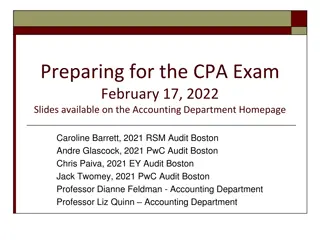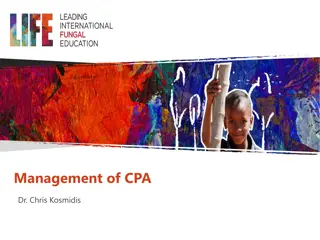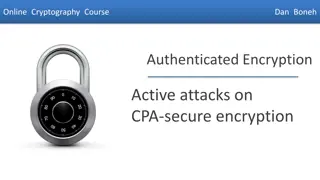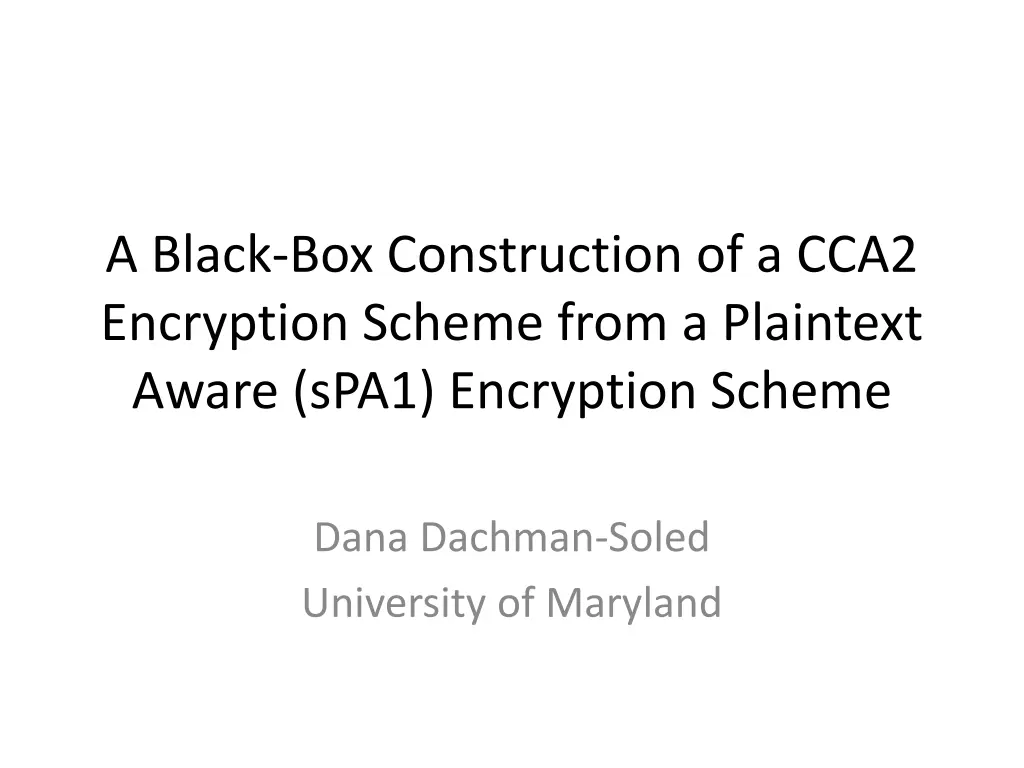
A Black-Box Construction of CCA2 Encryption Scheme
Explore the construction of a CCA2 encryption scheme from a plaintext-aware encryption scheme. Understand the implications of CPA security on CCA security, alongside the construction of CCA1 and CCA2 schemes from lower-level primitives. Discover how plaintext awareness and weakly simulatable public key encryption contribute to achieving CCA2 security. Delve into the assumptions, experiments, and results surrounding this innovative encryption scheme construction.
Download Presentation

Please find below an Image/Link to download the presentation.
The content on the website is provided AS IS for your information and personal use only. It may not be sold, licensed, or shared on other websites without obtaining consent from the author. If you encounter any issues during the download, it is possible that the publisher has removed the file from their server.
You are allowed to download the files provided on this website for personal or commercial use, subject to the condition that they are used lawfully. All files are the property of their respective owners.
The content on the website is provided AS IS for your information and personal use only. It may not be sold, licensed, or shared on other websites without obtaining consent from the author.
E N D
Presentation Transcript
A Black-Box Construction of a CCA2 Encryption Scheme from a Plaintext Aware (sPA1) Encryption Scheme Dana Dachman-Soled University of Maryland
CPA, CCA1 and CCA2 CPA-secure Public Key Encryption ??,?????(?0) ??,?????(?1)
CPA, CCA1 and CCA2 CCA1-secure Public Key Encryption ?? ?? ??,?????(?0) ??,?????(?1) ?? ??
CPA, CCA1 and CCA2 CCA2-secure Public Key Encryption ?? ?? ? ? ? ? ??,?????(?0) ??,?????(?1) ?? ??
Does CPA Security Imply CCA Security? [Naor, Yung 90], [Dolev, Dwork, Naor, 00] CPA + NIZK -> CCA1 and CCA2 Partial black-box separation [Gertner, Malkin, Myers, 07] no shielding construction of CCA1 from CPA. Question remains open! Even whether CCA1 -> CCA2 is not known. Long line of work showing black-box constructions of CCA2 encryption from lower level primitives. [Peikert, Waters 11], [Rosen, Segev, 10], [Kiltz, Mohassel, O Neill, 10]. . . Our work continues this line of research.
Our Results Theorem: There is a black-box construction of CCA2- secure encryption from plaintext aware (sPA1) and weakly simulatable public key encryption. Note: Construction is black-box, but reduction makes non-black-box use of the CCA2 adversary. [Myers, Sergi, shelat, 12]: Black-box construction of cNM- CCA1-secure encryption from the same assumptions. Our contribution: Extend to full CCA2 setting. Construction of a CCA2 scheme from encryption schemes with weaker security and no additional assumptions.
Our AssumptionsPlaintext Awareness ? = ciphertext creator, ? = extractor Intuition: ? knows the underlying plaintext. Note: ? uses ? in a non-black-box manner Note: No auxiliary input Experiment ???1 (?,?,? ,?): (?) pairs of public + secret keys are generated ?,? get random coins and public keys as input ? gets oracle access to ? ,? decrypts for ? Let ? be the set of queries asked by ? Experiment outputs 1 if ? decrypted all queries in ? correctly. Encryption scheme is ???1 -secure if for every ppt ?, there exists an extractor ? s.t. experiment outputs 0 with negligible probability.
Our AssumptionsWeak Simulatability ?samples ciphertexts without knowing the plaintext. ? 1 on input ?? and valid ciphertext outputs coins for ? Correctness: ? ??,? 1??,? = ? ? 1??,? = ?????? ?,? ??,? ,? Candidate constructions satisfying both assumptions ([MSs12]): Damgard Elgamal Encryption scheme (DEG) Cramer-Shoup lite (CS-lite)
Overview: CCA Proof Strategies Hyrid Public Key Challenge Ciphertext Decryption Oracle ?0 ?? ????? ?????(?0) Simulated ? ?1 Simulated ?? Simulated ??? . . . Main Challenge: Constructing the simulated decryption oracle PPT adversary cannot distinguish consecutive hybrids. ?? 1 To reduce to security of underlying encryption scheme, must simulate decryption oracle without knowing secret key. ?? ?? ????? ?????(?1)
CCA1 from Plaintext Awareness? Trivial: Plaintext Aware scheme is itself CCA1- secure! To simulate the decryption oracle without knowing the secret key, use the Extractor.
CCA2 from Plaintext Awareness? Is the plaintext aware scheme itself also CCA2-secure? An attempt: As before, simulate decryption oracle using Extractor. Problem: Extractor is no longer guaranteed to work in the second phase! Once adversary receives challenge ciphertext ? , Extractor can fail. E.g. adversary can re-randomize ? and submit to oracle. Note that our candidate Plaintext-Aware schemes are homomorphic! So these attacks are possible. Extractor seems to be useless. At first glance, seems as hard as proving that CCA1 -> CCA2. No: Having a faulty extractor algorithm is better than no extractor.
Our Construction Combines techniques from [Hohenberger, Lewko, Waters 12] and [Myers, Sergi, shelat 12] 1. Generate (?????,?????) for one-time signature scheme 2. Inner ciphertexts: ????0= ???????0(?0) ????1= ???????1(?1) Public keys are chosen based on ????? ?0 ?1= (?||?) ?1, ??= ???(?) 3. Outer ciphertexts: . . . ??1 ??2 ??3 ??? ?????? and randomness ?? ? encryptions of ????0||????1under ??? 4. Compute ? = ?????????(???|| ||???) 5. Output: (???, ,???,?????,?)
Proof Intuition Idea: Use extractor to simulate oracle even in the CCA2 case. Now the extractor may answer incorrectly after the adversary receives the challenge ciphertext. Call this event BadExtEvent
Proof Intuition Sequence of hybrids: Show that BadExtEvent occurs with negligible probability in final hybrid. For each hybrid, show that probability BadExtEvent occurs differs by a negligible amount. In order to prove this, reduction must always be able to detect a bad extraction event by comparing the output of the Extractor with the output of ?????.
Hard Case: Detecting BadExtEvent in CPA hybrid XOR to (?||?) Reduction to CPA security of inner ciphertexts XOR to random ?0= ???? ?0= ???? ?1= ???? ?0= ???? ?0= ???? ?1= ?0 (?||?) ????0 ????1 ????0 ????1 Idea for how to detect BadExtEvent: Randomly choose ? {0,1}. Show that the first BadExtEvent occurs on decryption of ????? with probability 1 2 Pr[???????????]. Say ? = 0. CPA adv. knows secret key for ????0 but not ????1. Can detect first BadExtEvent on ????0. Places challenge ciphertext in ????1 position. Note that in both hybrids, ?0 is individually uniformly distributed. Simulated oracle answers correctly until the first BadExtEvent.
Future Directions Can high-level proof techniques be useful for constructing CCA2 from CCA1? Non-black-box use of the adversary. Detecting a bad event without fully simulating the decryption oracle. Can we reduce the underlying assumptions of our construction?











